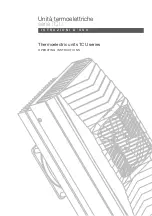
22
SECTION G:
FUEL STORAGE AND SUPPLY SYSTEM
EXTERNAL TANK INSTALLATION
External tank installations must comply with any applicable local Authority Codes or Rules. the following informa-
tion will be of interest to the owner.
1) Check your local Council website, or your installer, for local rules that apply to your installation address.
2) Remote Fuel Tanks must be installed “outside”.
3) The fuel tank vent must be a minimum of 1000 mm from any opening into the building. The definition of “Open-
ing” means fixed and opening windows and doors, and any foundation ventilation grates in raised floor homes.
4) Install the fuel tank so the bottom of the tank is not less than 400 mm above the surface of the floor upon which
the Laser Heater is installed. (For gravity to assist fuel flow to the heater).
5) Where the remote fuel tank can only be installed below the heater, (multi story homes and hillsides) an optional
“fuel lifter pump” is available to “lift” fuel from up to 8 m below the heater, to the heater. Contact your supplier
for further information.
6) To avoid excess gravity fuel pressure to heater, the top of the fuel tank must not be more than 2.5 m higher than
the floor surface upon which heater rests.
7) Fuel tank should be located at least 1.5 m away from all significant heat sources (Fuel Tank contents must not
exceed 40°C in normal operation ···).
8) Only use clean, new, soft drawn copper tubing for fuel line (8 mm or 5/16” OD). If necessary to braze joint
(extend) copper tube, ensure that internal “scale” caused by brazing, is blown away with dry compressed air,
dry nitrogen, CO2, or by allowing at least three liter’s of diesel to flow through the pipe to “wash away” internal
copper pipe “scale”, so the scale does not cause restriction the integral fuel filter /strainer (Part No 17187513).
Galvanized pipe fittings or fuel tanks must not be used to store or transport paraffin fuel.
9) To prevent “air locks” in fuel pipe, the path of the fuel line should be generally parallel to horizontal with no
U-shaped or “P” trap type “rise and fall” bends.
10) Use of a high quality fuel filter in fuel line adjacent to tank is recommended, also a shut-off valve at the fuel tank
outlet and a drain valve on the tank, as shown below.
11) “Fuel tanks must be fitted with an effective fuel filter.
12) Fuel pipe-work must be located or guarded so that it is protected against physical damage in normal service.
Secure with pipe saddles as appropriate.
Fuel filter
FR-700F
30 cm
minimum
Outdoor fuel tank
Shut-off valve
0.95 cm (3/8 in.)
OD copper tubing
Shut-off valve
2.5 m maximum
WARNING:
Only use clean, fresh, paraffin. NEVER USE GASOLINE, White Spirits, or other flammable liquids,
which can lead to explosive and destructive fire, and may cause serious injury or death.
☞
CHECKLIST
• Check whether the heater has been connected to a
suitable socket.
• Ensure that the fuel is free of water or other contami
-
nants.
• Check outside the building in order to ascertain that
there is no fuel or obstructions to the free circulation of
air in the area immediately adjacent tothe exhaust pipe.
• Inspect the inlet air hose for cracks, loose connec
-
tions or blockages.
• Check the outlet air hose for cracks, loose connec
-
tions or blockages.
• Check the back of the heater to ensure that the airflow
to the air circulation ventilator is notobstructed.
• Inspect the interior of the building to ensure that the
area immediately adjacent to the heater is free of fuel
and objects that may obstruct the free flowof air.
• Check that the room sensor is not exposed to draughts,
direct sunlight or heat radiated directly from the heater.
• Use a spirit level to check that the heater is level.
If this inspection brings any faults to light, resolve these
problems before using the heater.
Use only water-free high quality pure Kerosene.
Never use gasoline, LPG, camping gas or
other flammable liquids. The use of these
substances may cause explosions or fire.


































